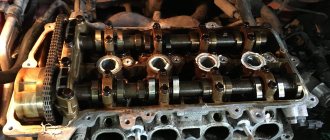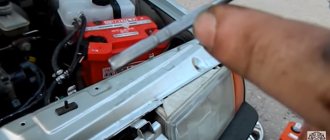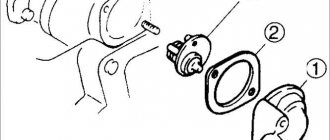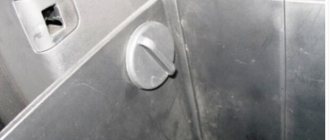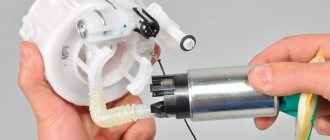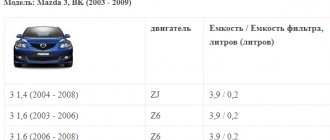Changing the engine oil is one of the simplest procedures when servicing a Kia Spectra, which you can do yourself quite quickly without difficulty, but if you get your hands dirty.
The oil is changed when the engine is warm.
The drain bolt in the Spekra engine crankcase is unscrewed with a “17” key. While the oil is draining, do not forget to unscrew the oil filter, cat. nom. 26300-2Y500, (access to it is somewhat difficult, you need to crawl from under the car). Before pouring fresh oil into the Kia Spectra engine, do not forget to tighten the drain plug and install a new oil filter (after pouring a little oil into it and lubricating the rubber seal).
According to the instructions, the Kia Spectra engine requires 3.6 liters. oil (for a dry engine) Hyundai/Kia 05100-00441 ACEA A3, and when replacing a VAZ it will take no more than 3 liters.
After changing the oil, start the engine, let it run for 5 minutes and check the level with a dipstick. To see the procedure for changing the oil on a Kia Spectra, watch the video.
Getting ready for replacement
Car engine
You need to drain the lubricating motor fluid after a short trip, while the engine has not yet cooled down. If the engine is cold, you need to start it and warm it up. Under no circumstances should you pour old grease onto the ground.
How much oil to pour?
Those drivers who are changing lubricant for the first time probably do not know how much to pour and what its consumption is in principle. Typically, about 3.5 liters of lubricant are required for replacement. Therefore, when going to the store, buy a four-liter canister.
What kind of oil should I use?
Four-liter canister of Castrol oil
It is best to fill in the same oil that was in the engine before. If you decide to change the brand, then before filling in a new one, you must wash the system with a special flushing compound or the same oil that you intend to use. That is, we drain the used lubricant and fill it with new one to the minimum level. We start the engine for 10-15 minutes. We drain the oil or flushing fluid, and only after this can we proceed to replacing the filter and filling in new lubricant. What kind of oil to pour is a purely individual matter, but it is better to stick to the brand recommended in the instructions. Many drivers recommend using Castrol 5W-40 and Shell 5W-40 synthetics, and choosing Sakura as an oil filter barrier, although again the choice is yours.
We are replacing
It is better to change the engine lubricant on a Kia Spectra in an inspection pit or overpass. If this is not possible, then you need to lift the car using a jack, while observing all safety precautions.
Tools
- new motor lubricant - volume 4 l;
- new filter;
- rags;
- container for used lubricant 4-5 liters;
- a set of keys;
- key for removing the filter.
Instructions
- First, the Kia Spectra crankcase protection is removed - to do this, you need to unscrew the bolts securing it.
Bolts that need to be unscrewed to remove the protection - Using a rag or brush, clean the drain plug from dirt.
- Using a key set to “seventeen”, unscrew the plug a couple of turns. We place a container for draining the waste liquid under the drain plug.
- Unscrew the drain plug completely. This is done carefully. Firstly, you can get burned by the waste liquid and, secondly, the drain plug may fall into the container.
- The drain plug has a copper gasket. If it has lost its original appearance, it must be replaced with a new one. Wait for the engine lubricant to drain completely and tighten the drain plug.
- Using a wrench to remove the filter, unscrew it. It's no longer needed.
- We prepare the new filter element for installation; to do this, fill it with a little more than half of fresh oil. Don’t forget to lubricate the rubber seal with a new lubricant.
- We install a new filter. Attention! When installing a new filter, you cannot use a key. This must be done carefully with your hands!
- We unscrew the filler cap, which is located at the top of the engine.
- Slowly pour new lubricant into the engine. It should take approximately three and a half liters. Check the lubricant level using a dipstick. It should be between o and "MAX".
- If necessary, add oil to normal.
- Start the engine, and be sure to watch the light indicating the oil level. If it burns, you need to add oil.
- Check that there are no leaks under the drain plug and oil filter. If you find any leaks, tighten them.
- Check the oil level again.
If everything is in order, the light is not on, there are no smudges, then you can consider the job done!
Unscrew the plug
Unscrew the plug completely
We inspect the copper gasket
Use a wrench to unscrew the old filter
Pour some oil into the filter
Lubricate the gasket
Installing a new filter barrier
Unscrew the plug
Loading …
So how often should you change your engine oil?
You can find many expert answers to this question, but it is best to follow the recommendations given by the vehicle manufacturer. He recommends changing the Spectra engine oil at least every 15 thousand kilometers or, if the annual mileage is less, every year. It is with this replacement frequency that the Kia engine will be least susceptible to internal wear. It should be noted that sometimes this procedure is required more often. In some cases, the interval between replacements should be reduced to 10 thousand kilometers. This is always associated with difficult operating conditions of the vehicle, for example in urban environments or dusty areas.
We recommend: Changing the oil in the VAZ 2113, 2114, 2115 engine
If you buy a car second-hand, then you need to change the oil in the Spectra engine immediately after purchase in order to protect yourself from problems if the previous owner did this a long time ago or filled in with low-quality fluid.
Along with the oil, the Kia Spectra oil filter must also be changed. Therefore, you need to immediately purchase this part. The advantage is that the prices for consumables for this car are low, as it should be in the budget class.
What kind of oil to put in a Kia Spectra box
On the Russian market, the car was assembled with both automatic and manual transmissions. According to the manufacturer's recommendations, the oil change must be done:
- for automatic transmission every 90,000 km, and check every 15,000 km. mileage
- for manual transmission every 15,000 km only check and replace based on oil contamination.
Technical requirements that must be observed when selecting gearbox oil:
- for manual transmission SAE 75W-90
- for automatic transmission SK ATF SP-III
Kia Spectra automatic transmission oils
The table below shows automatic transmission oils from leading oil manufacturers. These oil models have proven themselves on the positive side and are available in almost any auto parts store.
The oil volume in the Kia Spectra automatic transmission is 6.1 liters.
Selection of automatic transmission oil from online catalogs of manufacturers for Kia Spectra
| Castrol ATF Multivehicle | VALVOLINE ATF | ZIC ATF MULTI | LUKOIL ATF SYNTH ASIA | Shell Spirax S5 ATF X | MOBIL ATF 320 | ZIC ATF SP 3 |
| JASO 1A | JASO 1A | JASO M315 1A | JASO M315 Type 1A | JASO 1-A, 2A-02 | ||
| GM Daewoo | GM Dexron IID, IIE, III, IIIH, VI, 9986195, Autotrak II | GM Dexron II/III | GM DEXRON® TASA, IID/E, IIIG, IIIH | General Motors Dexron, Dexron II, Dexron III | GM Dexron III G | |
| Ford Mercon, Mercon V, SP, LV, FNR 5, XT-9-AMMF5 | Ford Mercon | Ford MERCON | Ford Mercon V, Mercon | Ford Mercon | ||
| Mitsubishi Diamond SP-II, SP-III | Mitsubishi Diamond SP-II, SP-III, ATF-J3, Dia Queen ATF-PA | Mitsubishi SP-III | Mitsubishi SP-II, SP-III | Mitsubishi ATF SP-I/II/III | ||
| Aisin Warner JWS 3309 | JWS-3309, JWS-3324 | JWS 3309 | JWS 3309 | Aisin JWS 3309 | ||
| Toyota Type T, T-II, T-III, T-IV | Toyota / Lexus Type T, T-III, T-IV, WS | Toyota Type T, T-II/III/IV | Toyota Type T-III, T-IV | Toyota T III, T IV | ||
| Kia-Hyundai | Kia-Hyundai SP-II, III, IV, SPH-IV, SP4-M, SP-14-RR | Hyundai/KIA ATF SP-III, CVTF H1 | Hyundai ATF | Hyundai-Kia ATF SP-III | ||
| Allison C-4 | Allison C-4 | Allison C-4 | Allison C-4 | |||
| Nissan Matic Fluid C, D, J | Nissan / Infiniti S, D, J, K, W-Matic | Nissan Matic Fluid C/D/J | Nissan Matic D, J | |||
| Suzuki ATF Oil and ATF Oil Special | Suzuki ATF 5D-06, AT 2384K, AT3314, AT3317, ATF B-IIE | |||||
| Mazda ATF D-III and ATF M-3 | Mazda CX-9, MV*, FZ | Mazda ATF M-III/V, ATF F-1 | Mazda ATF D-III, ATF M-3 | |||
| Daihatsu Alumix ATF Multi | Daihatsu ATF D-II/III | |||||
| Honda ATF Z-1 (not for CVT-transmissions) | Honda / Acura ATF-Z1 (not CVT), ATF-DW1 (not CVT) | Honda ATF Z-1 | Honda ATF Z-1 | |||
| Subaru ATF | Subaru ATF, ATF-HP | Subaru ATF, ATF-HP | ||||
| Jatco Automatic Transmission | ||||||
| Volvo 97341 | ||||||
| Chrysler ATF +/+2/+3/+4 | ||||||
| SsangYong DSIH 6P805 | ||||||
| BMW LT 71141, LA 2634, M-1375.4, 6 ETL-7045E, ETL-8072B, Volvo 1161521**, 1161540, STD 1273.41 ATF 3.0 |
Kia Spectra manual transmission oil
The oil in the box is selected in this table. It was made based on reviews from experts, car enthusiasts and manufacturer recommendations.
The oil volume in the Kia Spectra manual transmission is 2.15 liters.
Selection of gearbox oil from online catalogs of manufacturers for Kia Spectra
| Castrol Syntrax Universal Plus 75W-90 | VALVOLINE GEAR OIL 75W-90 | Shell Spirax S5 ATE 75W-90 | Shell Spirax S4 G 75W-90 | ZIC GFT 75W-90 |
| GL-4/ GL-5/ MT-1 | GL-4 | GL-4/ GL-5/ MT-1 | GL-4 | GL-4 / GL-5, MT-1 |
| MB-Approval 235.8 | MB-Approval 236.26 | |||
| ZF TE-ML 02B, 05A, 12L, 12N, 16F, 17B, 19C, 21A | ZF TE-ML 02B, 08 | |||
| MAN 341 Z2 MAN 342 S1 | MAN 341 Type Z2 | |||
| Scania STO 1:0 | ||||
| J2360 | VW G 009 317, G 052 512, G 50 | VW TL 501.50 | ||
| BMW MTF LT-2, LT-3 | ||||
| GM 1940764, 1940768 |
When should you change the oil in a Kia Spectra engine?
According to the regulations for changing the oil in a Kia Spectra 1.6 or other engine, the procedure is carried out every 10-15 thousand kilometers. Experts, however, do not recommend focusing on these indicators - under Russian operating conditions, the service life of the lubricant is significantly reduced.
The production of lubrication is also affected by the individual use of the vehicle. Among its factors are:
- aggressive driving, driving at high speeds;
- city traffic conditions, frequency of stops and turns;
- total engine load, towing other vehicles;
- condition and surface of roads, potholes, slippage;
- dustiness of the environment, seasonal and daily temperature fluctuations.
In the context of these aspects, pay attention to signs of the need to replace the lubricant. To do this, for preventive purposes, the oil is checked - its volume is measured and external data is assessed.
The amount of lubricant in the system in a heated and normal state should not exceed the limits indicated on the dipstick. Excess or lack of fluid leads to rapid wear of the operating engine mechanisms.
In terms of external characteristics, there is a significant change in color, the appearance of impurities and sediment, and a burnt smell. All this indicates the need to change the engine oil, regardless of the mileage traveled.
Kia Spectra owner reviews
With 1.6 engine
- Vladislav, Kaliningrad. The car is worth the money and is suitable for family and household needs. I like the car, I service it at the dealership. The salon is designed in a minimalist style, everything is simple and at hand. Under the hood there is a 1.6-liter engine that consumes 9-10 l/100 km.
- Vyacheslav, Kirovsk. A decent car, satisfied with most characteristics. For example, it has good overclocking potential, a comfortable and practical interior, an energy-intensive suspension and good music. Three tall passengers can sit in the back, with an average fuel consumption of 13 liters.
- Oleg, Novosibirsk. I have a 2004 Kia Spectra, a Russian-made car. I chose the version with a manual transmission and a 1.6-liter engine. I praise the car for its good dynamics and effective brakes. The sedan handles well, I'm pleasantly surprised considering the budget class. The average gasoline consumption per 100 km is 10 liters per 100 km. On the highway you can keep within 8-9 liters. The interior is quite spacious; I would also like to note simple and high-quality finishing materials.
- Anton, Dnepropetrovsk. I bought a Kia Spectra in 2003, with a 1.6-liter engine and manual transmission. Good overclocking potential, minimal noise level in the cabin, high level of comfort. In my opinion, the car is still relevant. In the city it consumes 10 liters.
- Oleg, Ryazan. A decent car, I don’t regret buying it. I'm talking about the 1.6-liter version with automatic transmission. In the city you can keep within 12 liters. It’s comfortable to drive with an automatic, but it’s a little thoughtful and not suitable for long overtaking. Because of the gearbox, the engine still lacks power, especially at high speeds outside the city.
- Dmitry, Stavropol region. I like the car, the best transport for every day. The wheelbarrow is used in the family and for household needs. With a 1.6-liter engine, you can fit in 11 liters of 95 gasoline.
- Daniil, Vologda region. Kia Spectra is the car of my youth, I will never sell it. In winter it is stored in the garage, since the car does not like our salty winters. In addition, I try to operate the Spectra in such a way that there is no corrosion, well, at least in the area of the door sills - these are the weakest points on the body. Average consumption with a 1.6-liter engine is 10 liters per 100 km, I have a version with a manual transmission.
- Alexander, St. Petersburg. A good car for its time, definitely better than the Renault Logan and other similar budget cars. The Spectra is a pretty serious car, fast and economical. I have a version with a manual transmission and a 1.6 engine, it consumes 12 liters during vigorous driving. The average consumption is 10 liters, on the highway it is about 8 liters/100 km.
- Maxim, Sverdlovsk. I'm happy with the car, a car for all occasions. The car is still in service. A productive car, fairly quiet and without annoying vibrations in the cabin. The 1.6-liter engine consumes 10 liters per 100 km. Acceleration to hundreds in 12 seconds, top speed 180 km/h. I have a manual version, this box better reveals the potential of the 1.6-liter. Outside the city I fit in 8 liters.
- Pavel, Lipetsk. An excellent car, it impresses with its good dynamics and acceleration potential, the maximum speed is under 200 km/h. The car is satisfactory in all respects, a decent car for the money. The 1.6-liter engine consumes from 8 to 11 liters.
With 1.8 engine
- Karina, Petrozavodsk. I got the car from my husband; he recently switched to a Toyota Corolla. In general, the car is worth the money, it is reliable and unpretentious in the city. True, the car must be serviced in a timely manner, for example, before each trip. And then the Spectra will bring driving pleasure, fortunately the chassis and handling are capable of this. The car gives me positive emotions, the average consumption is 10-12 liters per 100 km. Under the hood is a 1.8-liter engine with an automatic transmission.
- Irina, Moscow region. I'm happy with the car, I bought the Spectra in 2003 with a mileage of 199 thousand km. I have a version with a 1.8-liter engine, I fill it with 95 gasoline. The car consumes 10 liters per 100 km.
- David, Murmansk. A good car, relevant transport for daily trips. I have a 2004 Kia Spectra, I bought a car with a mileage of 100 thousand kilometers. The interior is quite comfortable; three passengers can sit in the back. The Spectra is moderately dynamic and comfortable, and does not bother you with breakdowns. In the urban cycle, fuel consumption is 10-11 liters per hundred km. I have a version with a 1.8-liter internal combustion engine and automatic transmission. The box runs smoothly and reveals the full potential of the engine, which is already quite powerful.
Kia Spectra oil filter: description, replacement procedure
Modern requirements for road transport are becoming increasingly higher. Many Russians are not satisfied with the car models produced by the domestic VAZ. Therefore, the Russian auto industry is looking for alternative options. One of them is the Kia Spectra passenger car, which has been produced at the Izhevsk automobile plant since 2005.
Background
The name Kia Spectra has been used by Koreans since 1993. The previous model, Sephia, was sold under this name in the USA (1993-1998). The same name was assigned to new Korean modifications of this model, which continued to be produced in America. At the same time, the car began to be produced by the Russian automobile industry.
The Russian version of the Kia Spectra has only one gasoline engine with a capacity of 100 horsepower, the volume of which is 1.6 liters. Transmissions – 5-speed manual or 4-speed automatic.
It depends on the modification. The car is characterized by convenience and ease of operation, as well as good adaptation to Russian roads. There are five configuration options.
We recommend: Description of Daewoo Nexia fuses: characteristics, diagram, photo and video
Unfortunately, the quality of Russian assembly leaves much to be desired.
Lubrication system
The internal combustion engine (ICE) is used as a power plant in modern cars. As in any mechanism, friction forces arise between its parts when they come into contact. The more closely the parts come into contact, the higher the friction force, which causes wear. In addition, this process is accompanied by active heat generation.
All these components enter the engine oil circulating through the channels of the lubrication system. Naturally, they worsen its composition and basic qualities, causing accelerated wear of parts. The inevitable consequences are a reduction in service life and repairs.
To prevent this from happening, the Kia Spectra engine lubrication system has an oil filter that performs an extremely important task - cleaning the composition of the lubricating fluid. Periodically, every 10 thousand kilometers, the Kia Spectra requires an oil change.
At the same time, the oil filter is also changed.
Filter element: design and operation
Lubricating fluid constantly circulates through the channels of the lubrication system. The pressure in the line is created by the oil pump. Under pressure, liquid enters the filter element through several round holes located around the perimeter of the lid.
The oil leaves the filter through the central hole in the same cover, having already been cleaned of dirt and pieces of metal. Thus, all the required qualities of the lubricating composition are maintained for as long as possible.
In the presented video, you can additionally familiarize yourself with the structure of the filter element, visually seeing it in cross-section.
The Kia Spectra non-separable oil filter consists of the following parts:
- frame,
- filter cartridge,
- overflow valve,
- check valve,
- spring,
- lid,
- sealing ring.
The lubricating fluid is cleaned with a filter cartridge. As a rule, it is made of cardboard impregnated with phenol-formaldehyde resins and folded in the form of an accordion. This design is necessary in order to maximize the area of contact between the cardboard and the oil. This achieves the maximum level of cleaning.
During the production process, cardboard is processed several times to improve its cleaning properties.
Valves play an important role in the operation of the filter. The reverse prevents lubricant from flowing into the crankcase when the engine is stopped. After all, if this happens, the engine will start without a lubricant, which can lead to rapid wear of parts.
The bypass is used to pass oil directly, without cleaning, when the filter is very dirty and cannot perform its main function. It also works when the lubricant thickens in frosty weather. Thus, excess pressure in the system is relieved.
The filter is characterized by the following parameters:
- inlet oil pressure;
- the maximum pressure difference required to activate the bypass valve;
- fineness of screening of the filter cartridge.
It is required to install the original one, which is recommended by the manufacturer. It is better not to use analogues, except as a last resort. The filter for Kia Spectra has the following characteristics:
- height – 65 mm;
- bypass valve opening pressure – 1 bar;
- diameter – 65 mm;
- diameter 2 – 62.9 mm;
- diameter 3 – 54.5 mm;
- thread – M20x1.5.
We recommend: Features of ignition on VW Passat cars: do-it-yourself repair and replacement
Ways to distinguish a fake from an original filter
The oil filter is an important element on which the life of the power plant significantly depends. Therefore, it is highly undesirable to install a counterfeit product on a car. The manufacturer cares about customers, and therefore endows its products with a number of characteristic distinctive features. Being vigilant by the car owner will help avoid purchasing a counterfeit.
First of all, it is recommended to inspect the packaging. The original is always made with clear contours. When making a counterfeit box, less saturated colors are used. You should read all available inscriptions. Counterfeit goods are often found to have spelling and other errors. The following are unacceptable in the original: skewed letters, their different heights and other printing and typographical flaws.
Inner wall of the original filter
You can identify a fake by the inner wall of the filter. In the original it is made of dense metal and has a characteristic perforation. The internal walls of the counterfeit are made of poor metal, often resembling foil. There is no proprietary perforation.
The inner wall is made of low-quality metal in a fake
You can spot a fake by looking at the rubber seal. The original is elastic and has no defects. The presence of sagging, uneven color, nicks, inclusions and other defects is unacceptable. In most cases, the fake seal is made of “tanning” rubber.
Elastic sealing rubber of the original filter
“Standard” counterfeit o-ring
If possible, it is recommended to weigh the filter. When making counterfeits, lower quality materials are used and in small quantities. Therefore, a counterfeit always weighs less than the original.
Weighing the original
Measuring the weight of a fake
In addition to the packaging, it is advisable to inspect the quality of the filter housing. A fake may have various printing defects. Those with labels should be checked against the packaging. The presence of errors or inconsistencies indicates that the car owner is faced with a counterfeit.
Frame with printing defects, from which it is easy to determine the counterfeit origin of the filter
The fake is made using low-grade metal. It rusts quickly. Therefore, the presence of any signs of corrosion is a serious reason to refuse the purchase, since the car owner is most likely faced with a counterfeit product.
Corrosion on the bypass valve of the fake filter
The original oil filter has a holographic sticker. It is made of material that is damaged when attempting to remove a hologram. Counterfeit products either have no holographic image or are of low quality.
Hologram
When identifying a fake, attention should be paid to the details. So the original and the counterfeit may have different rolling of the edges. For counterfeit goods, it is performed using cheaper technology. As a result, rolling marks leave visible tooth marks.
Comparison of original and fake rolling
Poor quality manufacturing of a counterfeit can be detected by inspecting the holes in the bottom of the oil filter. The holes are irregularly shaped. Counterfeit threads have defects in the form of distortions, nicks and burrs.
Bottom of the original filter
Uneven holes and poor threads on the fake
The fake and the original have different bypass valve designs. The branded filter is made using a spring plate. The fakes use a regular cheap spring.
Comparison of counterfeit and original bypass valve mechanisms
The fake and the original have different active filter parts. This can be seen after opening the consumables. The counterfeit product uses lower quality thin paper. The counterfeit filter element may have tears and through holes.
Comparison of the active filter part of the fake and the original

